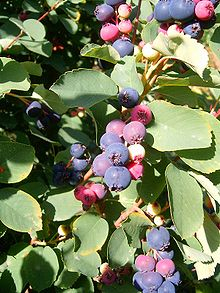Serviceberries For the Birds (And Me!)
 Monday, February 18, 2013 at 10:00PM
Monday, February 18, 2013 at 10:00PM One day last year I found myself driving down the road with leafy stems bouncing around my head, wondering what I would say if I were pulled over by a state trooper. Tree branches filled the front seat of my car, reaching out to explore the front windows and seeking to find escape through the roof. Two slender trunks occupied the center space between the seats. At the very back of the car their roots were contained within large plastic pots, lying on their sides and wedged against the rear lift gate.
When I purchased the two Serviceberry trees, I asked the attendant if he thought he could fit them into my mini van. No problem, I can do it, he said.
And he did. Yes, he did.
Amelanchier, AKA Serviceberry or Juneberry or Shadbush and a few other names as well, is a small tree with many North American species and some European ones. The fruit attracts bluebirds, cardinals, robins and other songbirds. The sweet, juicy berries look a lot like blueberries, but, unlike blueberries, they contain soft, almond flavored seeds. Humans like the berries, too, and they can be used instead of blueberries to make muffins, cobblers, preserves and jam. The berries are not often offered commercially, and it's not so easy to find the trees, either. So I was happy when I found two locally at a reasonable price.
 I hope I will soon have berries like these, shown in this public domain photo.
I hope I will soon have berries like these, shown in this public domain photo.
I haven't personally tasted the fruit yet. My two young trees produced only a handful of berries last year, which quickly disappeared. This year my trees are filled with blooms, so I am hoping for a more abundant crop. I am thinking one tree for the birds and one for me, though I suspect the birds won't abide by my thinking.
Serviceberries add ornamental value to the garden year round. Species may grow as shrubs or as small trees up to 25' tall. The branch structure is beautiful and the tree bark is often distinctive, with vertical fissures developing with age. In early spring, the branches are filled with clusters of white, five-petaled flowers, each bloom about 3/4" across.  The flowers are followed by shiny green, 2" long leaves. The tasty fruit usually ripens in June, thus the common name Juneberry. Fall color is excellent, with brilliant orange and gold color that persists for weeks.
The flowers are followed by shiny green, 2" long leaves. The tasty fruit usually ripens in June, thus the common name Juneberry. Fall color is excellent, with brilliant orange and gold color that persists for weeks.
With different species growing in zones 2-9, Amelanchier is usually easy to grow. Plant in moist but well draining soil in a site protected from strong winds. Full sun is best, but they will adapt to a partly shady location. Fertilize in November and maintain a 2"-3" layer of mulch around the base, making sure the mulch does not actually touch the bark. Water frequently during drought. Then enjoy your berries, if you can get to them before the birds. (Warning: deer also like them!)
 Permalink
Permalink  Amelanchier,
Amelanchier,  Juneberry,
Juneberry,  Serviceberry,
Serviceberry,  berries,
berries,  plants for wildlife in
plants for wildlife in  native plants,
native plants,  trees
trees 